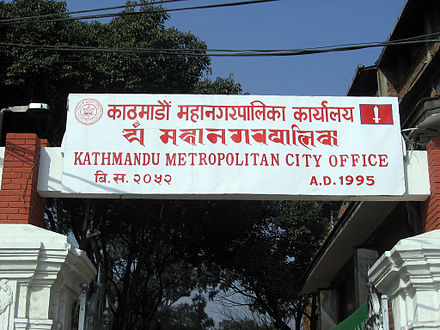Languages of Nepal, referred to as Nepalese languages in the country's constitution, are the languages having at least an ancient history or origin inside the sovereign territory of Nepal spoken by Nepalis.
There were 124 mother tongues according to the "National Report on caste/ethnicity, language & religion", National Population and Housing Census 2021 in Nepal.
Nepali accounted as a mother tongue for 44.86% while also being a second additional language for 46.2% of the total population.[1] Most belong to the Indo-Aryan and Sino-Tibetan language families.
The official working language at federal level is Nepali, but the constitution provisions each province to choose one or more additional official working languages.[2] The Language Commission of Nepal On September 6, 2021 recommended 14 official languages for different provinces of Nepal.[3]
The mother languages of Nepal, or languages of Nepali origin are sometimes referred to as Nepali languages.[4][5]
According to the constitution of Nepal, "All languages spoken as the mother tongue in Nepal are the languages of the nation".[6] Many of the languages also have various dialects. For example, the Rai community has about 30 languages. Some of the languages are similar and may be considered as a dialect. sometimes the distinction between dialects or completely different languages is unclear and might differ in opinions from person to person.[7]
Nepal's languages are mostly either Indo-European or Sino-Tibetan, while only a very few of them are Austro-Asiatic and Dravidian.
Out of 123 languages of Nepal, the 48 Indo-European languages, which are of the Indo-Aryan (Indic) sub-family (excluding English), constitute the largest group in terms of the numeric strength of their speakers, nearly 82.1%[8] of population. Nepali, Bhojpuri, Maithili, Awadhi, Tharu languages, Urdu, etc. fall in this group.
The Sino-Tibetan family of Nepal's languages forms a part of its Tibeto-Burman group. Though spoken by relatively fewer people than the Indo-European family (17.3%[8] of population), it includes a greater number of languages, about 63 languages. Languages belonging to this group are Tamang, Nepal Bhasa (Newar), Magar, Limbu, etc.
The small declining number of Dravidian languages are represented by Kurux, and the Munda languages of the Austroasiatic family by Santali and Mundari.
The indigenous languages of Nepal that predated the influx of Indic, Tibeto-Burman, and other families barely survive in the Kusunda language, which is nearly extinct today.[9]
Nepal also has at several indigenous village sign languages: Jhankot Sign Language, Jumla Sign Language, and Ghandruk Sign Language, in addition to the Nepali Sign Language designed for national use.[10]

Part 1 of the Constitution of Nepal 2015 (2072 B.S.) contains these provisions about the languages of Nepal:[2]
There were 124 mother tongues according to the "National Report on caste/ethnicity, language & religion", National Population and Housing Census 2021 in Nepal.
Nepali accounted as a mother tongue for 44.86% while also being a second additional language for 46.2% of the total population.[1]
There were 124 mother tongues according to the "National Report on caste/ethnicity, language & religion", National Population and Housing Census 2021 in Nepal.111 were previously reported in the earlier census 2011 and 13 were newly found in the census 2021.
The newly added mother tongues were Bhote, Lowa, Chum/Nubri, Baragunwa, Nar-Phu, Ranatharu, Karmarong, Mugali, Tichhurong Poike, Sadri, Done, Munda/Mudiyari and Kewarat. [1]
Population by mother tongue and sex, NPHC 2021[1]
There were 25 languages that were being used as second language by more than 10 thousand population on each in the "National Report on caste/ethnicity, language & religion", National Population and Housing Census 2021 in Nepal, whereas there were only 18 such languages reported as second language in the earlier census 2011.[1]
Population by second language, NPHC 2021

Nepali in Devanagari script is the official working language in federal level. The constitution has provisioned provinces to choose one or more than one official language(s) besides Nepali.[2] According to the Language Commission of Nepal Maithili and Limbu are recommended to have official status in Province No. 1; Maithili, Bhojpuri and Bajjika in Province No. 2; Tamang and Nepal Bhasa in Bagmati Province; Magar and Gurung in Gandaki Province; Tharu and Awadhi in Lumbini Province; Nepali (Khas Bhasa)'s Karnali dialect and Magar in Karnali Province; Dotyali and Tharu in Sudurpashchim Province.[3]
Most of the languages are found exclusively in oral form. According to the Language Commission, fifteen scripts are currently in use in Nepal,[3][11] including the following: